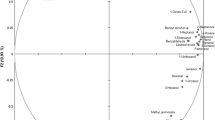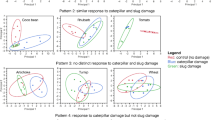Abstract
The volatile chemicals produced by four poaceous plant species, blue thatching grass, Hyparrhenia tamba, Napier grass, Pennisetum purpureum, sorghum, Sorghum bicolor, and maize, Zea mays, which are host plants for the lepidopterous stemborers, Chilo partellus and Busseola fusca, were collected by air entrainment and analyzed by gas chromatography. The total quantities of volatiles collected hourly, over a 9-hr period, from P. purpureum and H. tamba showed an approximately hundredfold increase in the first hour of the scotophase. Thereafter, the amount decreased rapidly to levels present during photophase. Although onset of scotophase also triggered an increase in quantities of volatiles collected from two cultivars of S. bicolor and two out of three cultivars of Z. mays, these increases were less dramatic than in the two wild grasses, being only up to 10 times as much as in the last hour of photophase. Analysis showed that up to 95% of the increase in volatiles at the onset of the scotophase was due to just four compounds, the green leaf volatiles hexanal, (E)-2-hexenal, (Z)-3-hexen-1-ol, and (Z)-3-hexen-1-yl acetate, with the latter dominating the volatile profile. Volatiles from P. purpureum were also collected at 10-min intervals for 70 min spanning the transition from light to dark. The vast increase in production of the green leaf volatiles in this species occurs in the first 10 min of the scotophase followed by a rapid decline within the next 20 min. The relevance of these results to the control of stemborers in a “push–pull” strategy is discussed.

Similar content being viewed by others
References
Agelopoulos, N. G., Hooper, A. M., Maniar, S. P., Pickett, J. A., and Wadhams, L. J. 1999. A novel approach for isolation of volatile chemicals released by individual leaves of a plant in situ. J. Chem. Ecol. 25:1411–1425.
Ampofo, J. K. O. 1986. Maize stalk borer (Lepidoptera: Pyralidae) damage and plant resistance. Environ. Entomol. 15:1124–1129.
Bate, N. J. and Rothstein, S. J. 1998. C6-volatiles derived from the lipoxygenase pathway induce a subset of defence-related genes. Plant J. 16:561–569.
Birkett, M. A., Chamberlain, K., Guerrieri, E., Pickett, J. A., Wadhams, L. J., and Yasuda, T. 2003. Volatiles from whitefly-infested plants elicit a host-locating response in the parasitoid, Encarsia Formosa. J. Chem. Ecol. 29:1589–1600.
De Moraes, C. M., Mescher, M. C., and Tumlinson, J. H. 2001. Caterpillar-induced nocturnal plant volatiles repel conspecific females. Nature 410:577–580.
Graus, M., Schnitzler, J. P., Hansel, A., Cojocariu, C., Rennenberg, H., Wisthaler, A., and Kreuzwieser, J. 2004. Transient release of oxygenated volatile organic compounds during light–dark transitions in Grey Poplar leaves. Plant Physiol. 135:1967–1975.
Hatanaka, A. 1993. The biogeneration of green odour by green leaves. Phytochemistry 34:1201–1218.
Hatanaka, A., Kajiwara, T., and Sekiya, J. 1987. Biosynthesis pathway for C6-aldehydes formation from linolenic acid in green leaves. Chem. Phys. Lipids 44:341–361.
Holzinger, R., Sandoval-Soto, L., Rottenberger, S., Crutzen, P. J., and Kesselmeier, J. 2000. Emissions of volatile organic compounds from Quercus ilex L. measured by proton transfer reaction mass spectrometry (PTR-MS) under different environmental conditions. J. Geophys. Res. 105:20573–20579.
Karl, T., Curtis, A. J., Rosenstiel, T. N., Monson, R. K., and Fall, R. 2002. Transient releases of acetaldehyde from tree leaves—products of a pyruvate overflow mechanism? Plant Cell Environ. 25:1121–1131.
Kfir, R. 1992. Seasonal abundance of the stemborer Chilo partellus (Lepidoptera: Pyralidae) and its parasites on summer grain crops. J. Econ. Entomol. 85:518–529.
Khan, Z. R. and Pickett, J. A. 2004. The ‘push–pull’ strategy for stemborer management: A case study in exploiting biodiversity and chemical ecology, pp. 155–164, in G. M. Gurr, S. D. Wratten and M. A. Altieri (eds.). Ecological Engineering for Pest Management: Advances in Habitat Manipulation for Arthropods. CABI Publishing, Wallingford, Oxon, UK.
Khan, Z. R., Pickett, J. A., van den Berg, J., Wadhams, L. J., and Woodcock, C. M. 2000. Exploiting chemical ecology and species diversity: stem borer and striga control for maize and sorghum in Africa. Pest Manage. Sci. 56:957–962.
Khan, Z. R., Pickett, J. A., Wadhams, L. J., and Muyekho, F. 2001. Habitat management strategies for the control of cereal stemborers and striga in maize in Kenya. Insect Sci. Appl. 21:375–380.
Lazzari, C. R., Minoli, S. A., and Barrozo, R. B. 2004. Chemical ecology of insect vectors: The neglected temporal dimension. Trends Parasitol. 20:506–507.
Ndemah, R., Gounou, S., and Schulthess, F. 2002. The role of wild grasses in the management of lepidopterous stem-borers on maize in the humid tropics of Western Africa. Bull. Entomol. Res. 92:507–519.
Ngi-Song, A. J., Njagi, P. N. G., Torto, B., and Overholt, W. A. 2000. Identification of behaviourally active components from maize volatiles for the stemborer parasitoid Cotesia flavipes Cameron (Hymenoptera: Braconidae). Insect Sci. Appl. 20:181–189.
Pare, P. W. and Tumlinson, J. H. 1996. Plant volatile signals in response to herbivore feeding. Fla. Entomol. 79:93–103.
Päts, P. 1991. Activity of Chilo partellus (Lepidoptera: Pyralidae): eclosion, mating and oviposition time. Bull. Entomol. Res. 81:93–96.
Rebe, M., van den Berg, J., and McGeoch, M. A. 2004. Colonisation of cultivated and indigenous graminaceous host plants by Busseola fusca (Fuller) (Lepidoptera: Noctuidae) and Chilo partellus (Swinhoe) (Lepidoptera: Crambidae) under field conditions. Afr. Entomol. 12:187–199.
Seshu-Reddy, K. V. and Sum, K. O. S. 1992. Yield–infestation relationship and determination of economic injury level of the stemborer, Chilo partellus (Swinhoe) in three varieties of maize, Zea mays L. Maydica 37:371–376.
Sellegri, K., Umann, B., Hanke, M., and Arnold, F. 2004. Deployment of a ground-based CIMS apparatus for the detection of organic gases in the boreal forest during the QUEST campaign. Atmos. Chem. Phys. Discuss. 4:3835–3873.
Turlings, T. C. J., Bernasconi, M., Bertossa, R., Bigler, F., Carloz, G., and Dorn, S. 1998. The induction of volatile emissions by three herbivore species with different feeding habits: Possible consequences for their natural enemies. Biol. Control 11:122–129.
van den Berg, J., van Rensburg, J. B. J., and Pringle, K. L. 1991. Comparative injuriousness of Busseola fusca (Lepidoptera: Noctuidae) and Chilo partellus (Lepidoptera: Pyralidae) on grain sorghum. Bull. Entomol. Res. 82:137–142.
Acknowledgments
Teodora Toshova was the recipient of a Royal Society Fellowship. Rothamsted Research receives grant-aided support from the Biotechnology and Biological Research Council of the UK. The work was also supported by the UK Department for the Environment, Food, and Rural affairs (DEFRA).
Author information
Authors and Affiliations
Corresponding author
Rights and permissions
About this article
Cite this article
Chamberlain, K., Khan, Z.R., Pickett, J.A. et al. Diel Periodicity in the Production of Green Leaf Volatiles by Wild and Cultivated Host Plants of Stemborer Moths, Chilo partellus and Busseola fusca . J Chem Ecol 32, 565–577 (2006). https://doi.org/10.1007/s10886-005-9016-5
Received:
Revised:
Accepted:
Published:
Issue Date:
DOI: https://doi.org/10.1007/s10886-005-9016-5




